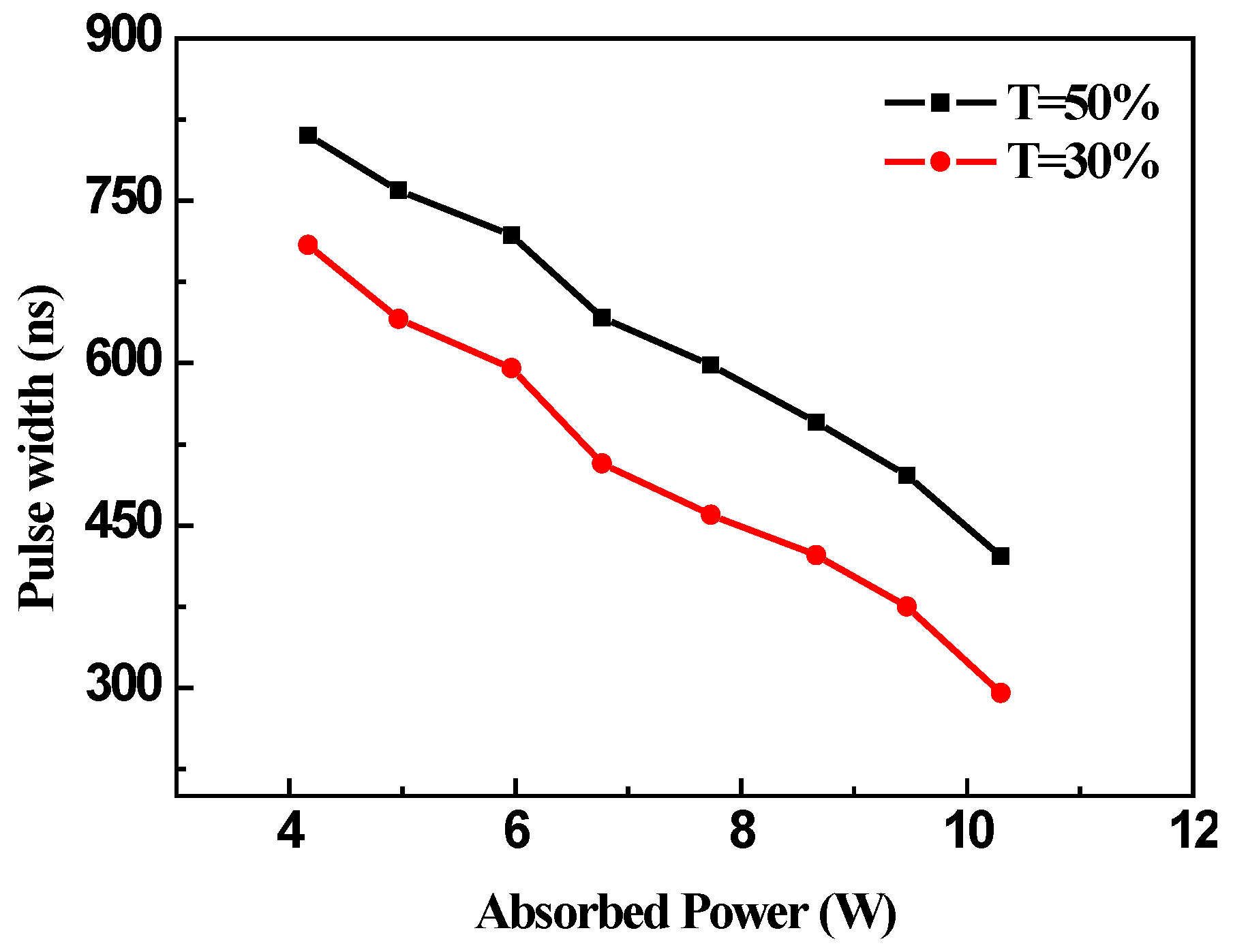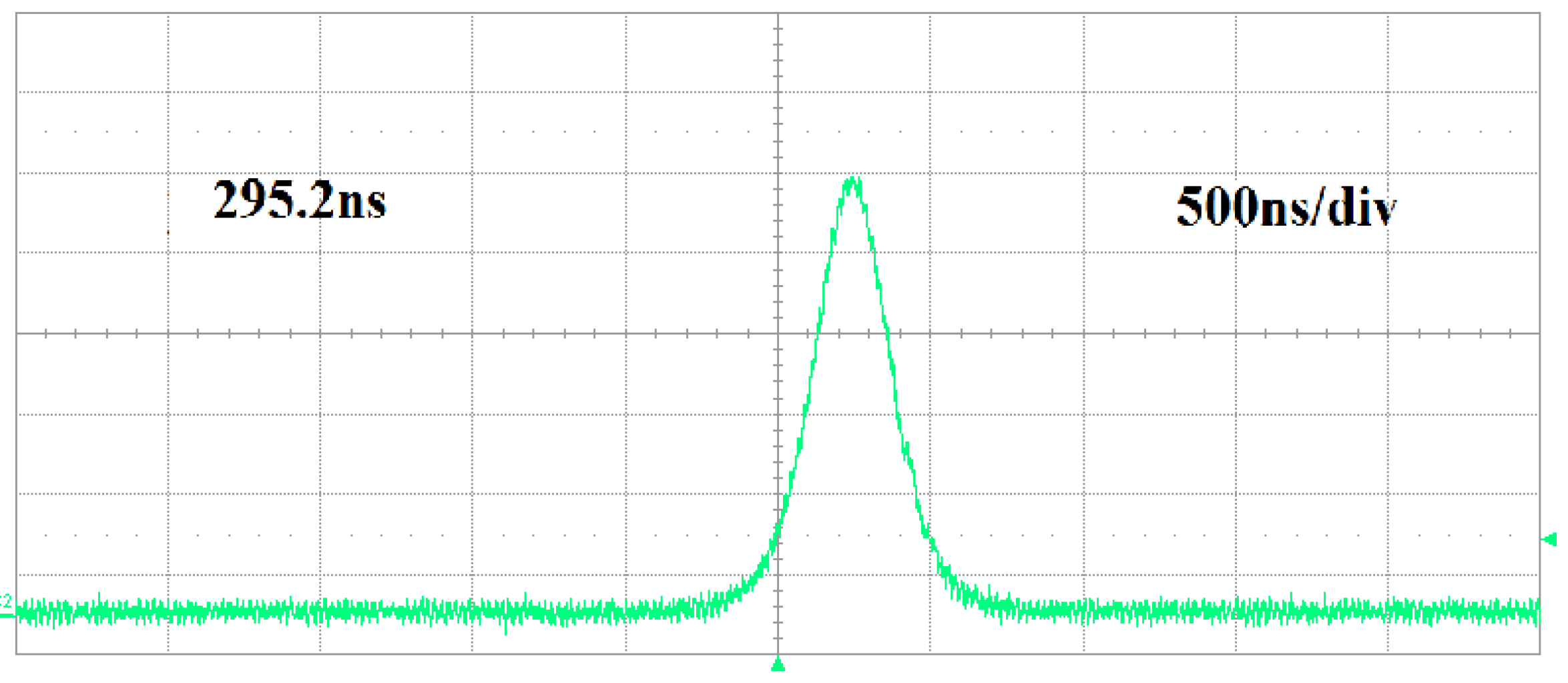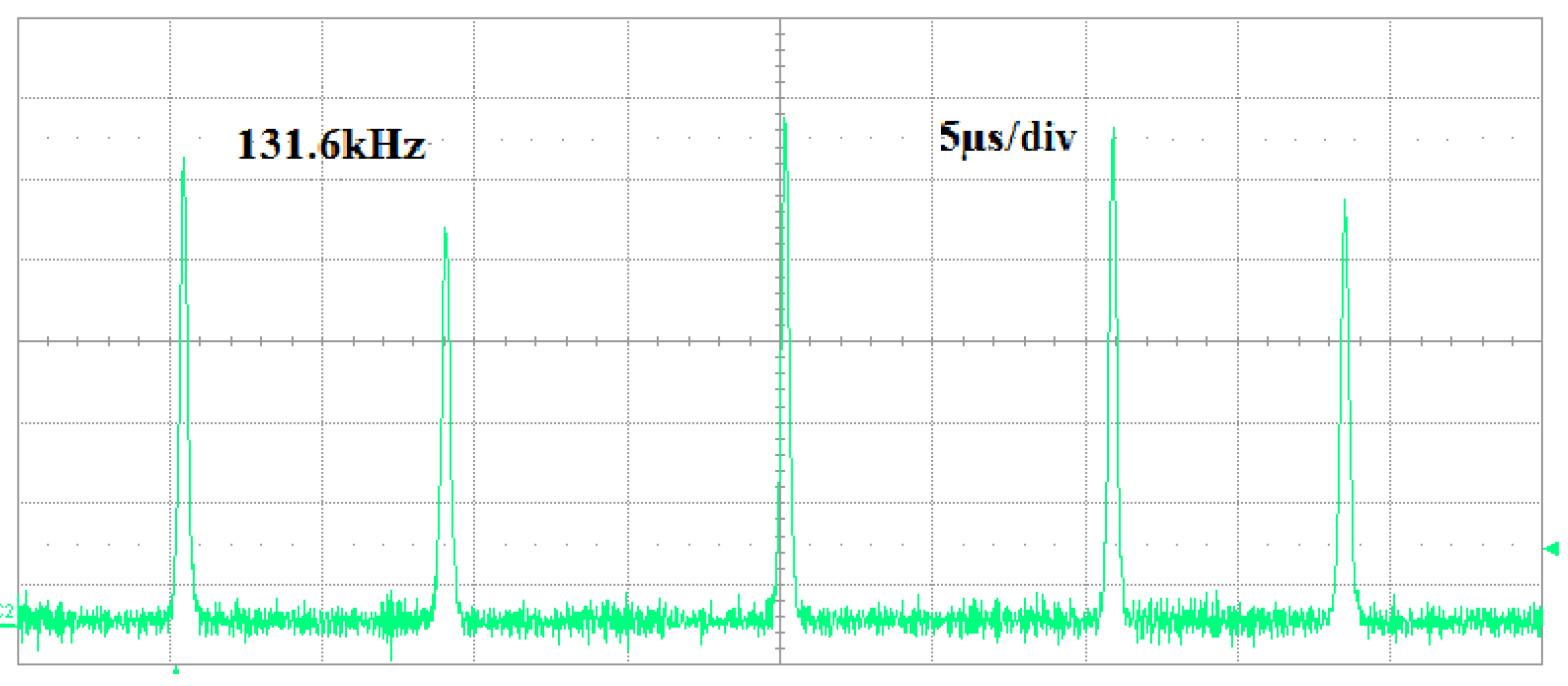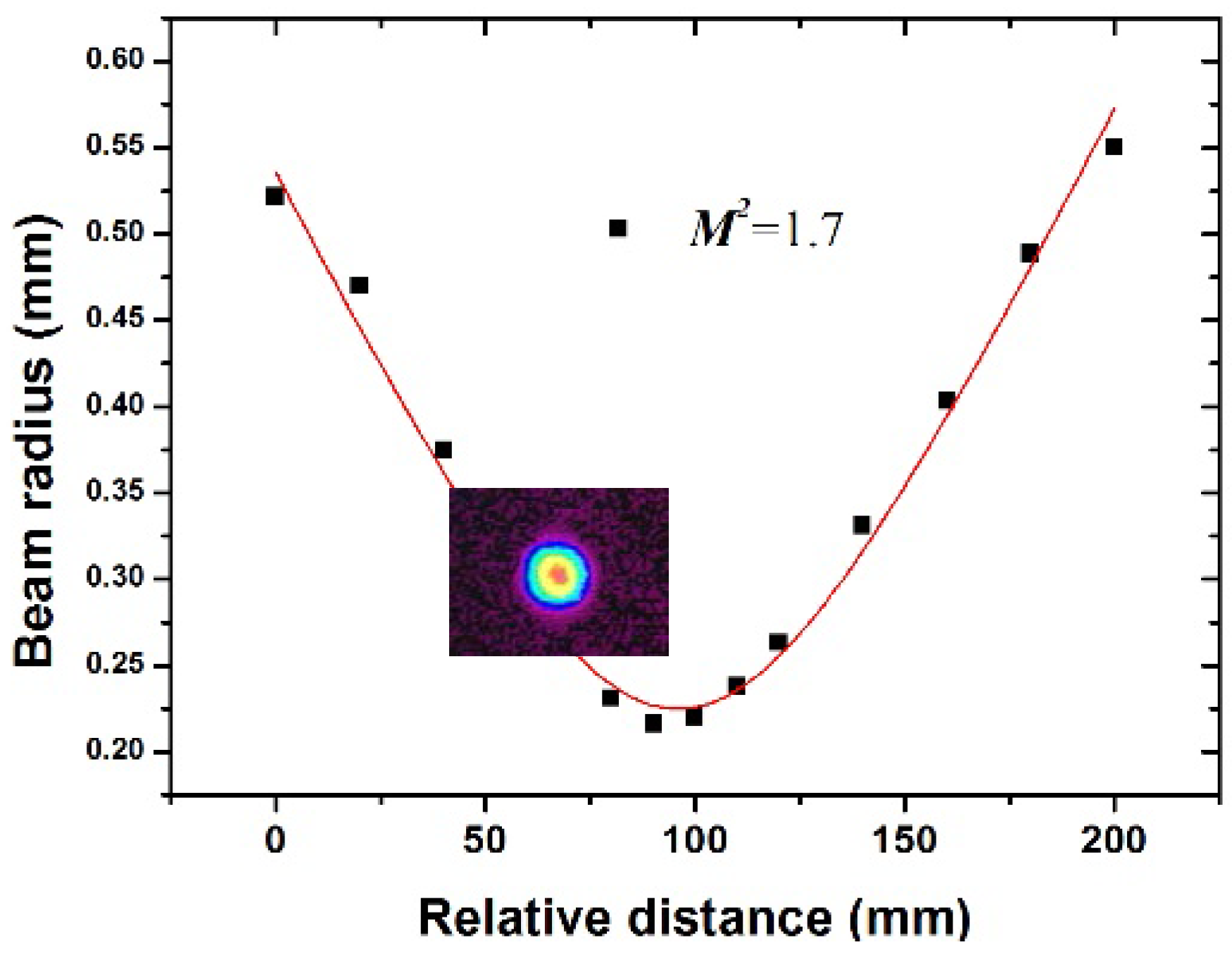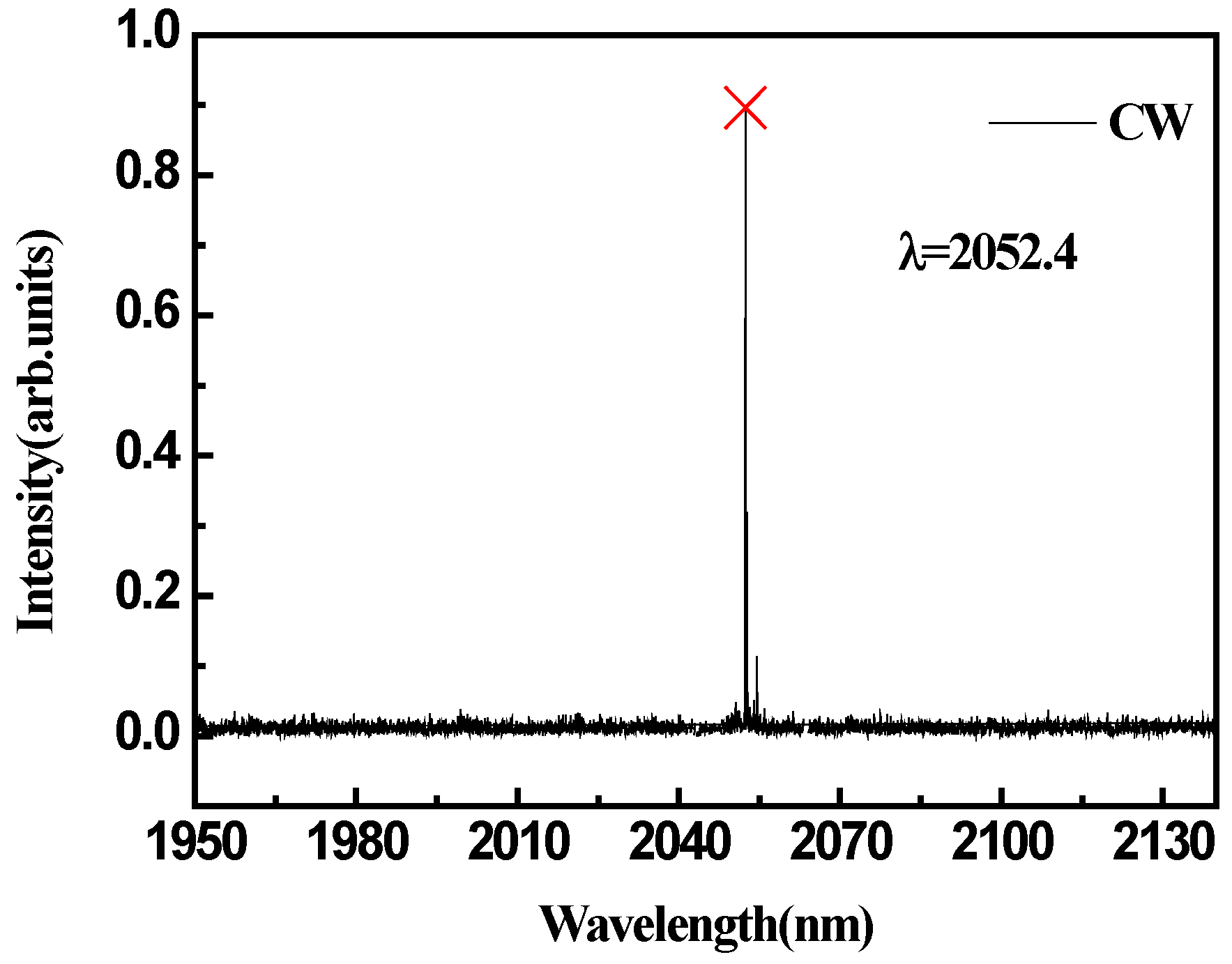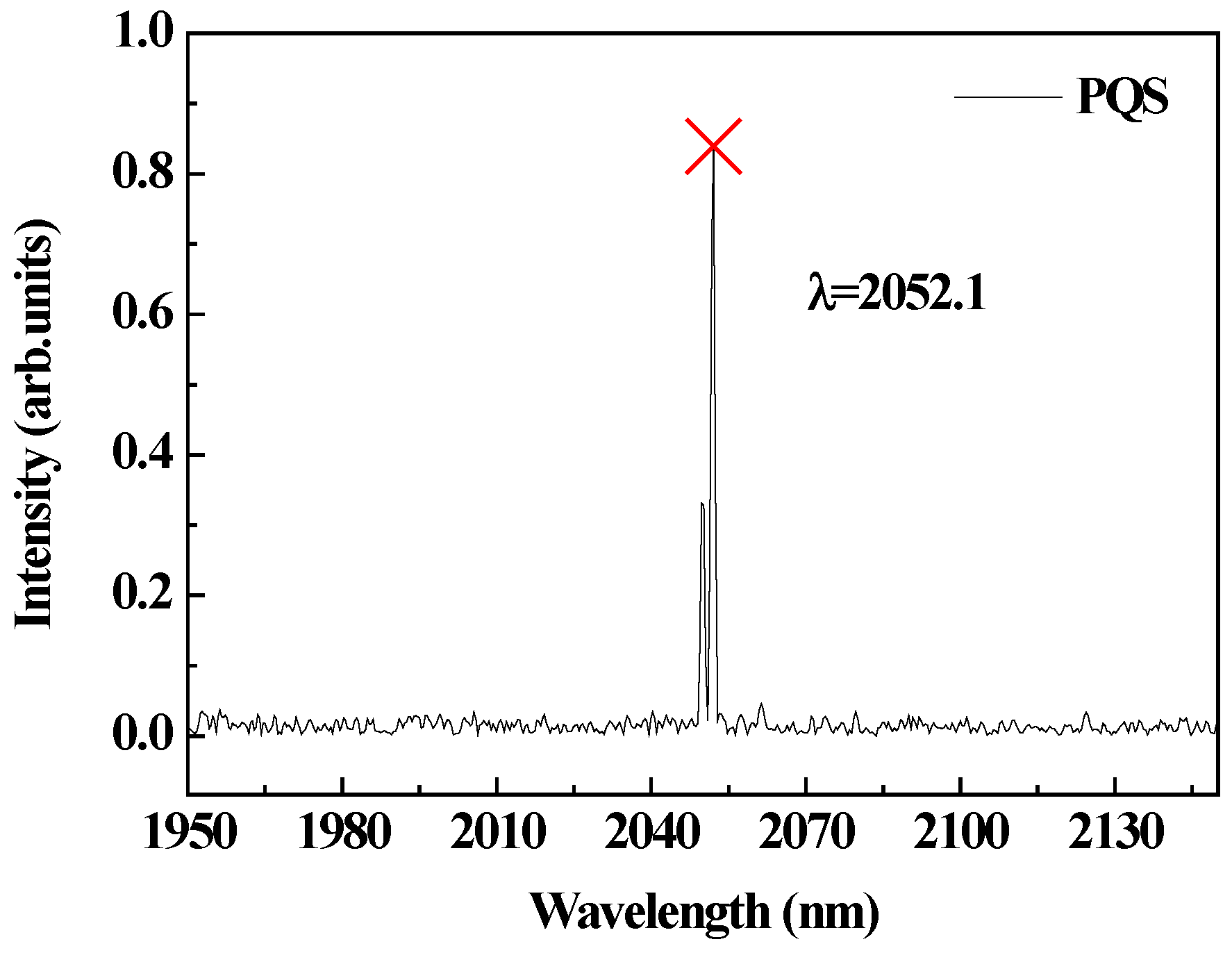1. Introduction
The laser sources near 2 µm have an extensive application in a variety of scientific and technical applications, such as laser radar, ranging, and remote sensing [
1]. By shifting wavelengths with the use of optical parametric oscillators (OPOs), it is possible to provide very broad wavelength-tuning ranges, which generally require drive levels attained with high-peak-power pulses and near-diffraction-limited beams [
2]. Q-switching is one of the main techniques enabling highly efficient pulsed lasers. Passive Q-switching features a more compact geometry and simpler setup than active, which requires additional switching electronics [
3]. In particular, Q-switched laser sources operating in 2 µm still generally rely on direct emission of Tm or Ho lasers. Compared with Tm
3+, Ho
3+ has a larger emission cross section and a longer upper state lifetime, which helps to achieve high-peak-power pulses. Therefore, Ho-doped laser is very suitable for the passively Q-switched (PQS) laser operations.
In the past few years, PQS Ho lasers have been demonstrated with different saturable absorbers (SA) based on semiconductor or nanometer materials. In 2001, Tsai
et al. inserted a Cr
2+: ZnSe SA into a flash-lamp-pumped Ho:YAG laser resonator, and acquired 1.3 mJ pulse energy and 90 ns pulse duration [
4]. In 2009, Z.G. Wang
et al. used Cr
2+:ZnS to obtain a PQS Tm,Ho:GdVO
4 laser with the maximum energy of 2 mJ at 20 Hz with a pulse width of 170 ns [
5]. In 2011, X.L. Zhang reported a PQS Tm,Ho:YLF laser with Cr
2+:ZnS SA, the pulse width was about 1.25 µs, with the pulsed energy of 4 µJ [
6]. In the same year, Loiko
et al. proved the feasibility of using PbS quantum-dot-doped glass as SA in a Ho:KLu(WO
4)
2 laser, acquired the maximum average output power of 84 mW and the shortest pulse duration of 30 ns [
7]. In 2014, S. Wang
et al. reported a MoS
2 passively Q-switched Tm:Ho:YGG laser with 410-ns pulses and 206-mW average output power [
8]. In 2014, Z.Q. Luo
et al. reported a Topological-insulator passively Q-Switched double-clad fiber laser with the shortest pulse width of 4.18 μs and the tunable repetition rate from8.4 to 26.8 kHz [
9]. In 2015, Z.P. Qin
et al. used a black phosphorus Q-switched fiber laser delivers a maximum average power of 485 mW with pulse width of 1.18 μs at repetition rate of 63 kHz [
10].
Graphene, which is a two-dimensional sheet of sp
2-bonded carbon atoms arranged in a honeycomb lattice [
11], has caused a flood of activities in the past few years, especially have particular capability in nonlinear saturable absorption. Graphene is a zero-bandgap material and the absorption in graphene is only determined by optical conductivity constant and independent of optical frequency. Thus graphene is an alternative for ultra-broadband saturable absorbers. Further investigations show that graphene has an ultrafast recovery time and moderate modulation depth, which suggests that it is a suitable saturable absorber for passive mode locking and Q-switching [
12]. Considering its low saturation intensity, low-cost and easy fabrication, Graphene is an ideal SA [
13]. At present, studies on passive Q-switching with graphene as saturable absorber are mainly focused on Nd-lasers and Er-lasers. In 2011, X.L. Li reported a graphene passively Q-switched Nd:GdVO
4 laser with 105-ns pulses and 2.3-W average output power [
14]. In 2013, Z.X. Zhu demonstrated a passive Q-switched Er:YAG laser with an average output power of 528 mW and the pulse energy of 7.08 µJ [
15]. Up to now, graphene has also been employed as a saturable absorber in Q-switched laser sources operating in 2 µm. In 2011, Q Wang
et al. demonstrated a passive Q-switched Tm:YAG laser with a graphene SA, and the shortest pulse duration was 2.08 μs [
16]. In 2013, T.L. Feng
et al. proved the graphene as SA in a Tm:LSO laser, acquired the maximum pulse energy of 14.0 μJ and the shortest pulse duration of 7.8 μs [
17]. In 2014, Z. Cui
et al. used graphene to obtain a PQS Ho:LuAG laser with the maximum output power of 0.37 W with a pulse width of 784.7 ns [
18]. In 2014, by using a graphene SA, a PQS Ho:YAG laser was demonstrated with the pulse width of 632 ns and pulse energy of 13.3 μJ [
19].
However, there have been no reports on Ho:YVO
4 laser with graphene as saturable absorber as far as we know. Ho:YVO
4 has been shown to be an excellent laser host for 2 μm laser radiation [
20]. It is sufficiently hard (Mohs hardness 5), nonhygroscopic, and resistive to chemicals, with large emission cross section and long fluorescence decay lifetime of Ho
5I
7 manifold (∼4 ms). In addition, the elative large absorption cross section at 1.94 μm [
21], makes the Ho:YVO
4 able to be efficiently resonant pumped by 1.94 μm Tm:YLF or Tm:YAP lasers [
22]. In 2015, Dai
et al. demonstrated a high repetition frequency passive Q-switched Ho:YVO
4 laser with Cr
2+:ZnS SA, and the highest pulse energy of 70.3 μJ was obtained at the absorbed pump power of 30.4 W [
23].
In this paper, by using graphene as a saturable absorber, a Tm:YAP pumped passively Q-switched Ho:YVO4 laser at 2.05 μm is presented. The output characteristics including the average output power, the pulse width, as well as pulse repetition frequency were demonstrated. At the absorbed pump power of 9.3 W, the maximum average output power of 2.2 W was obtained in Ho:YVO4 laser with minimum pulse width of 265.2 ns and pulse repetition rate of 131.6 kHz at 2052.1 nm. As far as we know, this is the first time that PQS Ho:YVO4 solid-state lasers at 2 μm have been obtained by using a multilayer graphene SA.
2. Experimental Section
The Ho:YVO
4 crystal, with dimensions of 5 × 5 × 33 mm
3, doped with 0.7 at. % Ho and antireflection coated at the pump and laser wavelengths. The crystal was wrapped in indium foil and press-fitted into a copper block serving as a heat sink at a temperature of 25 °C, with a low absorptivity, at about 30%. The L-cavity Ho laser resonator is shown in
Figure 1, in which a plano-concave cavity with a length of 100 mm was employed. The pump source was a diode-pumped Tm:YAP laser (manufacture by National Key Laboratory of Tunable Laser Technology, Harbin Institute of Technology, Harbin, China) operating at 1.94 µm, with a maximum output power of 35 W. The pump beam was focused into the laser crystal by
f = 150 mm lenses with a spot of 300 µm in diameter. The crystal was located between the plane mirror (M1) and the 45-deg dichroic mirror (M2), which both were high-transmission (HT) coated at 1.94 μm and high-reflection (HR) coated at 2.1 μm. The output coupler, a plane mirror (M3) with curvature radius of 300 mm, was located 50 mm from M2. A multilayer graphene as a Q switch was located between M2 and M3, whose faces were antireflection (AR) coated near 2.1 μm, leading to a transmission of
T0 = 89%. The graphene we chose for our experiment was produced by chemical vapor deposition (CVD). Compared with graphene-polymer composites and epitaxial growth on SiC, the graphene produced by CVD has many advantages such as lower defects, a large area and controllable grapheme layers [
24]. The dimension of the graphene was 7 × 7 mm
2 in cross section. By changing the incident fluence, the transmission of graphene increased from 89% to 98%. The measurement shows that the graphene has a modulation depth of 10%. Moreover, the modulation depth of graphene saturable absorber increases by increasing the number of graphene layers, which will shorten the pulse duration in the Q-switched laser system. According to [
15], the thickness of graphene film should be three atomic layers.
3. Results and Discussion
Through changing the transmittance of the output coupler, which were transmission of 50% (T = 50%) and transmission of 30% (T = 30%), influence on output characteristics of Ho:YVO4 laser has been analyzed. The output couplers were selected because in a preliminary experiment we investigated with transmission of 10%, 20%, 30% and 50%. Stable PQS were achieved for T = 30% and 50%, as well as provided better stability and repeatability of the pulse train. With lower transmittances, damage was shown on the surface of graphene and instable pulse trains were observed on the oscilloscope. The following figures show the performance of the Ho Q-switched versus the pump power. The pulsed wave operation started at 4.1 W absorbed pump power.
Figure 2 shows the average output powers
versus the absorbed pump power. From
Figure 2, we can see the average output powers increases as the increase of absorbed pump power. In PQS mode, the maximum average output power of 2.2 W can be obtained by using an output coupler with
T = 30% at the absorbed pump power of 9.3 W. The slope efficiency is 12%. For the transmission of 50%, the slope efficiency is 9% with the maximum average output power of 1.5 W. In the continuous wave (CW) mode, the maximum output powers change to 3.35 W and 3.72 W, with the output couplers of
T = 30% and
T = 50%, respectively. The slope efficiencies are 17% and 20%. This is because the increase of pumping power will result in the increase of the ratio of the initial and threshold inversed population. The average output power and the efficiency of the Q-switched laser were lower than that in the CW mode, which could be attributed to the intra-cavity loss caused by inserting graphene for the Q-switched laser. The measured slope efficiency is well below the quantum efficiency. We attribute this to the low absorptivity of Ho crystal. Other factors that should be considered are difficulties with accurate mode matching between the pumping beam and oscillation beam.
The variation of the pulse width and the repetition frequency
versus the absorbed pump power under different transmissions of output coupler are shown in
Figure 3 and
Figure 4, respectively. From
Figure 3, we can see that all the pulse width decreases with the increase of the pumping power. For the two different output couplers of
T = 30% and
T = 50%, the pulse widths decrease from 709.1 to 295.2 ns, from 810.5 to 421.5 ns, respectively. We attribute this pulse shortening to the larger gain of the resonator when the transmission of the output coupler is low. Low output coupler transmission is usually beneficial to the energy storage and to realize the pulsed laser easily, further improving the pulse energy and reducing the pulse duration of Q-switched laser. The population stored in the upper-level manifold became large under the low Q value of the resonator. When the graphene became bleached, the resonator was under a high Q value, the photon in the resonator appeared to increase rapidly at a shorter time that produced a narrower pulse duration with a slight change of the pump power.
As for the repetition frequency, we can see from
Figure 4 that they all increase with the augment of the pump power. For the
T = 30% and
T = 50%, the pulse repetition frequency (PRF) grows with the pump power from 31.8 to 131.6 kHz, from 44.6 to 122.7 kHz, respectively. Moreover, we can find that the pulse width and pulse repetition frequency of Ho:YVO
4 laser can be controlled by choosing an output coupler and changing the pump power through the analysis. According to the data of average output power and pulse repetition, we can calculate the pulse energy, which is shown in
Figure 5. As we can see, the maximum output pulse energy is 16.8 µJ for 117.6 kHz repetition rate with T = 30%. The highest single-pulse energy shows at 9 W, which is not the highest absorbed power. We attribute this to the damage of the graphene and the unwanted heating of the SA by the residual pump, since the graphene was not attached to a cooler. The improvement of the pulse train and the pulse energy and reducing the pulse duration of Q-switched laser should be achievable by optimizing layer number of graphene and transmission coefficient of the output coupler.
Figure 6 plots a typical pulse envelope, having full width at half maximum (FWHM) 265.2 ns with
T = 30%.
Figure 7 shows the pulse train for a typical laser output at the maximum output power 2.2 W, which was achieved at the absorbed pump power of 9.3 W, the corresponding pulse width was 265.2 ns and the PRF was 131.6 kHz. With the increase of the pump power, damage was shown on the surface of graphene and we observed an instable pulse train on the oscilloscope. The stability of the pulse train is not good, which can be attributed to the absorbed heat on the graphene, as mentioned before. With the stable operation of the Q-switched laser even at the large loss brought by the unwanted heating, we believe that if we further wrap the graphene with a cooler, shorter pulses and higher single pulse energy should be possible.
To determine the beam-propagation factor (
M2), we routed the Ho laser’s radiation through a 150-mm-focal-length lens and measured the beam radius by using a knife straight edge, which is shown in
Figure 8. A typical two-dimensional beam profile is shown in
Figure 8 as well. The data were fitted by least-squares analysis to standard mixed-mode Gaussian beam propagation equations. Derived from standard beam-propagation expressions, the fit yields
M2 = 1.7. We attribute it to the mode of the pump laser. By using a spectrum analyzer (Bristol Instrument 721A), the output wavelength of Ho:YVO
4 laser in both CW and PQS modes were measured with absorbed pump power of 2.2 W and
T = 30%, which are shown in
Figure 9 and
Figure 10. The shift of the central wavelength resulted from the varied resonator loss. The inversion population density was very high when the laser pulse began to build as a result of the intra-cavity losses increased greatly when inserting the graphene SA into the cavity, which resulted in the output central wavelength under the PQS operation blue-shifting relative to the CW operation. While changing the transmission of the output coupler, the wavelength did not change.


